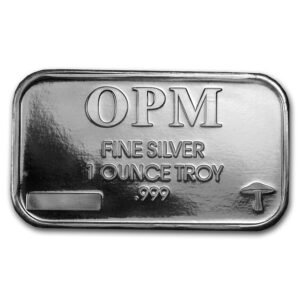The metals industry, especially the precious metals sector, prides itself on trust, transparency, and a sense of heritage that ties back centuries. However, every so often, controversies arise that shake the foundations of these industries. One such scandal involved OPM (Ohio Precious Metals), a well-known name in the refining and minting world, and the curious case of silver bars marked with a distinctive “mushroom privy.”
Background on OPM and Privy Marks
OPM Metals, one of the largest and most reputable refiners of precious metals in the U.S., had a longstanding reputation for producing high-quality silver and gold bars. The company was known for its environmentally conscious practices, producing metals with a low carbon footprint and adhering to stringent recycling standards.
Privy marks, small distinctive symbols engraved on coins and bars, are often used to indicate limited editions or special events. They can also serve as security measures or to commemorate significant moments in history. Collectors and investors often seek out such marks as they can add value to the item, making it more unique.
The “mushroom privy” mark appeared on some silver bars from OPM, but it wasn’t an innocuous addition to the bars, as collectors would soon discover.
The Scandal Unfolds
In the mid-2010s, reports began to surface about irregularities associated with OPM’s silver bars marked with the mushroom privy. The bars, which were supposed to be of high-quality silver, were found to be impure or adulterated. Concerns mounted over the authenticity and content of the silver in these bars.
Several investigations revealed that the silver content in the bars was significantly lower than advertised, which meant that buyers and investors had been duped into purchasing metals of far less value. The mushroom privy mark, originally seen as a mark of distinction or a special edition feature, became a symbol of the scandal, representing deceit and loss for many.
How the Scheme Worked
It was alleged that certain individuals within OPM or their distribution networks were involved in diluting the silver content of the bars. Instead of being composed of .999 fine silver, which is standard for investment-grade bullion, some bars contained inferior metals mixed in, severely reducing their intrinsic value.
The mushroom privy, which had been used as a marketing tool to attract collectors and investors, became the focal point of the scandal. It appeared that bars featuring this specific privy were the most frequently adulterated, leading many to believe that the mark was used to signify which bars were part of the scheme. Whether or not the privy was deliberately chosen to hide the fraud remains unclear, but its presence became synonymous with the scandal.
Legal and Financial Repercussions
Once the scandal broke, the metals industry was quick to act. Buyers who had invested in these silver bars felt betrayed, leading to a class-action lawsuit against OPM and related parties. OPM, which had long been considered a leader in ethical practices, suffered immense damage to its reputation.
Authorities launched an investigation into the origins of the scandal, trying to trace who was responsible for the adulteration of the silver bars. However, the complex nature of the precious metals supply chain made it difficult to pinpoint the culprits. OPM, despite its tarnished reputation, cooperated with authorities, claiming that they were unaware of the fraud happening under their brand.
The financial fallout was significant. Collectors who had paid premiums for the mushroom privy-marked bars found their investments had been drastically devalued. Many investors were left holding bars that were worth far less than what they had paid, and the price of silver itself took a hit as confidence in the bullion market wavered.
The Industry Response
In response to the scandal, the precious metals industry implemented more stringent regulations and procedures to prevent such fraud in the future. Refineries and mints introduced more sophisticated measures to authenticate and track their products, using advanced technology such as blockchain and unique serial numbers to trace the origins of each bar and coin.
Additionally, third-party testing of metals became more common, as investors sought assurance that the bullion they were buying was genuine and met the advertised specifications. Independent testing companies began offering services to verify the purity of silver and gold bars, giving buyers more confidence in their purchases.
The Legacy of the Mushroom Privy Scandal
The mushroom privy incident remains a dark chapter in the history of the precious metals market. It served as a cautionary tale, reminding investors to always conduct due diligence and to trust but verify when it comes to bullion purchases.
Today, the mushroom privy has become a symbol of fraud within the industry, and collectors and investors alike remain wary of bars marked with that particular symbol. The OPM metals scandal, while damaging in the short term, led to increased transparency and trust in the industry as a whole, as companies took steps to ensure that such fraud could not happen again.
Conclusion
The OPM metals scandal serves as a reminder of the importance of trust in the precious metals industry. While the mushroom privy was initially an innocuous symbol, it became the hallmark of a significant fraud that affected countless investors. The lessons from this scandal continue to resonate with collectors, investors, and companies alike.



